DDR5 Demystified - Feat. Samsung DDR5-4800: A Look at Ranks, DPCs, and Do Manufacturers Matter?
by Gavin Bonshor on April 7, 2022 8:00 AM EST- Posted in
- Memory
- Intel
- Samsung
- Micron
- SK Hynix
- DDR5
- Alder Lake
- DDR5-4800
- 12th Gen Core
- Z690
Gaming Performance Benchmarks: DDR5-4800
To show the performance of DDR5 memory in different configurations, we've opted for a more selective and short-form selection of benchmarks from our test suite. This includes Civilization VI, Grand Theft Auto V, and Strange Brigade (DirectX 12).
All of the tests were run with all of the memory at default (JEDEC) settings, which means DDR5-4800 CL40, regardless of the configuration, e.g, 2x16, 2x32, and 4x16 GB.
Civilization 6
Originally penned by Sid Meier and his team, the Civilization series of turn-based strategy games are a cult classic, and many an excuse for an all-nighter trying to get Gandhi to declare war on you due to an integer underflow. Truth be told I never actually played the first version, but I have played every edition from the second to the sixth, including the fourth as voiced by the late Leonard Nimoy, and it is a game that is easy to pick up, but hard to master.
Benchmarking Civilization has always been somewhat of an oxymoron – for a turn based strategy game, the frame rate is not necessarily the important thing here and even in the right mood, something as low as 5 frames per second can be enough. With Civilization 6 however, Firaxis went hardcore on visual fidelity, trying to pull you into the game. As a result, Civilization can taxing on graphics and CPUs as we crank up the details, especially in DirectX 12.
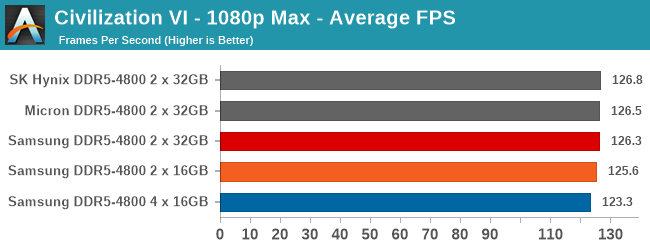

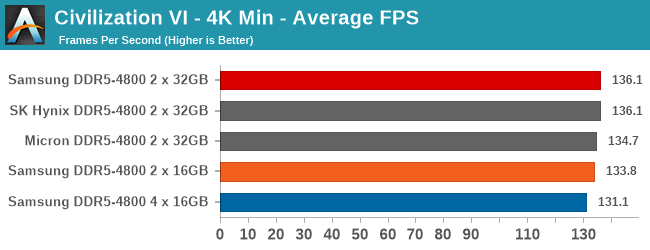
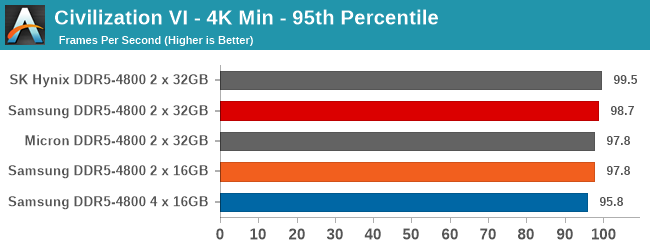
Despite games traditionally being a GPU bottleneck instead of a CPU/memory bottleneck, in our Civ VI testing we do find some small but statistically meaningful differences in our results. The 2 x 32 GB kits were the best of the bunch, with the Samsung 2 x 16 GB kit running slightly slower. The Samsung 4 x 16 GB kit however performed a couple of frames per second slower than the rest, coming in a bit over 3% slower than the 2 x 32 GB Samsung kit.
Grand Theft Auto V
The highly anticipated iteration of the Grand Theft Auto franchise hit the shelves on April 14th 2015, with both AMD and NVIDIA to help optimize the title. At this point GTA V is super old, but still super useful as a benchmark – it is a complicated test with many features that modern titles today still struggle with. With rumors of a GTA 6 on the horizon, I hope Rockstar make that benchmark as easy to use as this one is.
GTA doesn’t provide graphical presets, but opens up the options to users and extends the boundaries by pushing even the hardest systems to the limit using Rockstar’s Advanced Game Engine under DirectX 11. Whether the user is flying high in the mountains with long draw distances or dealing with assorted trash in the city, when cranked up to maximum it creates stunning visuals but hard work for both the CPU and the GPU.
The in-game benchmark consists of five scenarios: four short panning shots with varying lighting and weather effects, and a fifth action sequence that lasts around 90 seconds. We use only the final part of the benchmark, which combines a flight scene in a jet followed by an inner city drive-by through several intersections followed by ramming a tanker that explodes, causing other cars to explode as well. This is a mix of distance rendering followed by a detailed near-rendering action sequence, and the title thankfully spits out frame time data. The benchmark can also be called from the command line, making it very easy to use.
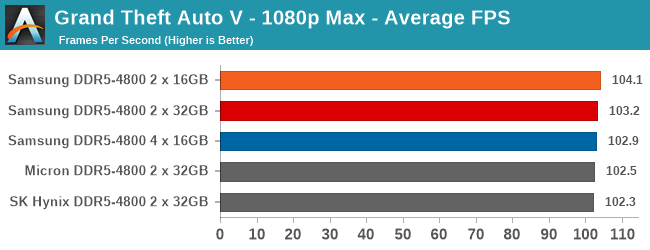



Using Grand Theft Auto V's built-in benchmark at 1080p, all of the JEDEC DDR5-4800B kits performed competitively with each other – albeit with a higher degree of variability than usual due to the nature of the game. Still, in our 4K testing, we see that Samsung 4 x 16 GB kit once again brings up the rear, this time falling behind the 2 x 32 GB kit by 7%.
Strange Brigade (DX12)
Strange Brigade is based in 1903’s Egypt and follows a story which is very similar to that of the Mummy film franchise. This particular third-person shooter is developed by Rebellion Developments which is more widely known for games such as the Sniper Elite and Alien vs Predator series. The game follows the hunt for Seteki the Witch Queen who has arisen once again and the only ‘troop’ who can ultimately stop her. Gameplay is cooperative-centric with a wide variety of different levels and many puzzles which need solving by the British colonial Secret Service agents sent to put an end to her reign of barbaric and brutality.
The game supports both the DirectX 12 and Vulkan APIs and houses its own built-in benchmark which offers various options up for customization including textures, anti-aliasing, reflections, draw distance and even allows users to enable or disable motion blur, ambient occlusion and tessellation among others. AMD has boasted previously that Strange Brigade is part of its Vulkan API implementation offering scalability for AMD multi-graphics card configurations. For our testing, we use the DirectX 12 benchmark.
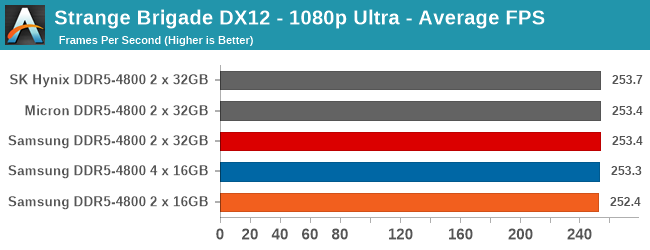
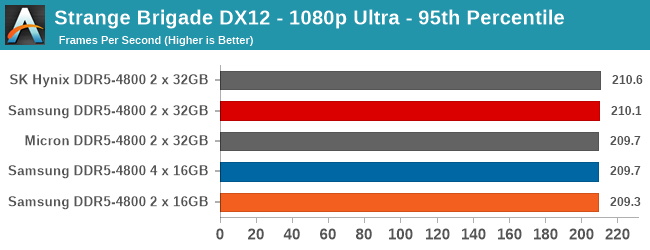
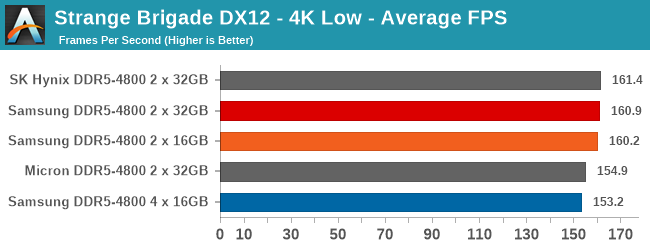
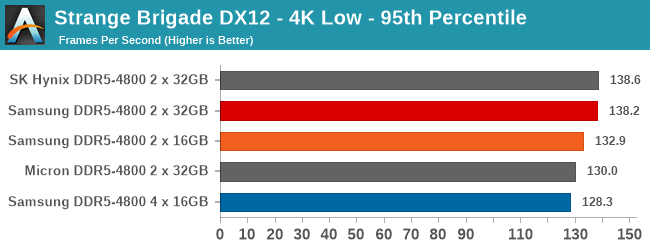
There wasn't much difference in our testing between the 2 x 32 GB kits in our Strange Brigade Direct X12 testing. At 4K, the Samsung 4 x 16 GB once again performed slightly slower than the rest, although Samsung's 2 x 16 GB configuration performed in-line with the 2 x 32 GB kits.


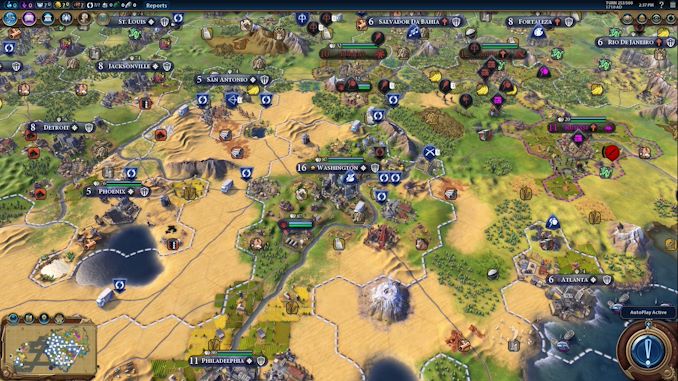
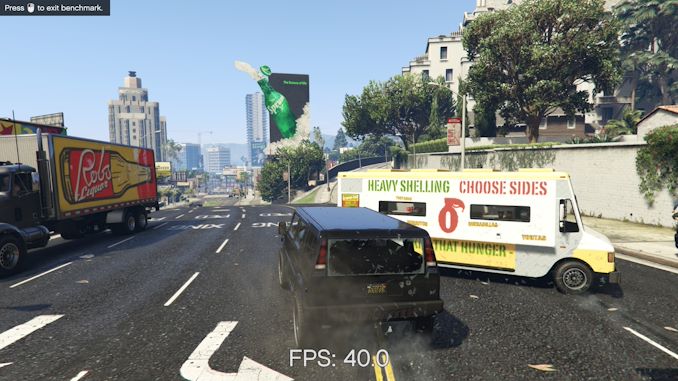









66 Comments
View All Comments
DanNeely - Thursday, April 7, 2022 - link
Only 16Gb of ram will be dual channel, the top 24GB will be single channel and half as fast. If it prevents having to swap you'll still see a benefit; but if you need - or think you'll need - more than 16gb of ram at some point during the laptops lifespan you should avoid any models with 8gb soldiered.Ryan Smith - Thursday, April 7, 2022 - link
We don't have any laptops like that in house right now. But I'll make note of that for once we get a DDR5 laptop in with such a configuration.zforgetaboutit - Thursday, April 7, 2022 - link
Benchmark Speedometer 2.0 - suspicious scores seenWhen I ran it (from your link) 3 times, my overall score was 170+ each time, which is 11% better than your best score. How can this be? Please advise.
my sample run
---------------
Detailed Results
Iteration 1 168.7 runs/min
Iteration 2 152.0 runs/min
Iteration 3 177.1 runs/min
Iteration 4 173.5 runs/min
Iteration 5 173.3 runs/min
Iteration 6 179.7 runs/min
Iteration 7 166.4 runs/min
Iteration 8 163.4 runs/min
Iteration 9 178.6 runs/min
Iteration 10 176.0 runs/min
Arithmetic Mean:171 ± 6.1 (3.6%)
---------------------------------------------------------------------
I have middle-of-the-road 4 x 8GB DDR4-2133 @ ~1440 GHz, running on an Intel i7-6700k, as follows
CPU-Z TXT Report
-------------------------------------------------------------------------
CPU-Z version 1.99.0
...
Memory SPD
-------------------------------------------------------------------------
DIMM # 1
SMBus address 0x50
Memory type DDR4
Module format UDIMM
Module Manufacturer(ID) Corsair (7F7F9E0000000000000000000000)
SDRAM Manufacturer (ID) SK Hynix (AD00000000000000000000000000)
Size 8192 MBytes
Max bandwidth DDR4-2133 (1066 MHz)
Part number CMK32GX4M4A2666C16
Nominal Voltage 1.20 Volts
EPP no
XMP yes, rev. 2.0
AMP no
DIMM # 2
SMBus address 0x51
Memory type DDR4
Module format UDIMM
Module Manufacturer(ID) Corsair (7F7F9E0000000000000000000000)
SDRAM Manufacturer (ID) SK Hynix (AD00000000000000000000000000)
Size 8192 MBytes
Max bandwidth DDR4-2133 (1066 MHz)
Part number CMK32GX4M4A2666C16
Nominal Voltage 1.20 Volts
EPP no
XMP yes, rev. 2.0
AMP no
DIMM # 3
SMBus address 0x52
Memory type DDR4
Module format UDIMM
Module Manufacturer(ID) Corsair (7F7F9E0000000000000000000000)
SDRAM Manufacturer (ID) SK Hynix (AD00000000000000000000000000)
Size 8192 MBytes
Max bandwidth DDR4-2133 (1066 MHz)
Part number CMK32GX4M4A2666C16
Nominal Voltage 1.20 Volts
EPP no
XMP yes, rev. 2.0
AMP no
DIMM # 4
SMBus address 0x53
Memory type DDR4
Module format UDIMM
Module Manufacturer(ID) Corsair (7F7F9E0000000000000000000000)
SDRAM Manufacturer (ID) SK Hynix (AD00000000000000000000000000)
Size 8192 MBytes
Max bandwidth DDR4-2133 (1066 MHz)
Part number CMK32GX4M4A2666C16
Nominal Voltage 1.20 Volts
EPP no
XMP yes, rev. 2.0
AMP no
zforgetaboutit - Thursday, April 7, 2022 - link
I'm running Win10 (latest), Chrome v100.0 .Ryan Smith - Thursday, April 7, 2022 - link
"I'm running [...] Chrome v100.0 ."That's likely why. We're locked to an fixed (older) version of Chrome in order to prevent software updates from breaking the apples-to-apples nature of our testing.
zforgetaboutit - Thursday, April 7, 2022 - link
I see your point.Then there's also a possibility Chrome may have improved by 10% since your version.
DanNeely - Thursday, April 7, 2022 - link
Chrome improving, or getting worse, from one version to the next is Ryan's point.zforgetaboutit - Thursday, April 7, 2022 - link
That's his point that I saw.repoman27 - Thursday, April 7, 2022 - link
Intel also distinguishes between systems with 1 or 2 DIMM slots routed per channel. The supported timings for the various configurations as listed in the Alder Lake datasheets are:1DPC (1 DIMM slot routed per channel):
DDR5-4800 40-40-40 2N
2DPC (2 DIMM slots routed per channel):
1DPC populated = DDR5-4400 40-37-37 2N
2DPC populated 1R/1R = DDR5-4000 36-34-34 2N
2DPC populated 2R/2R = DDR5-3600 (timings not specified)
So it should be noted that all of these tests were conducted with the memory controller in an overclocked condition. And although you state that all tests were performed at default settings as per firmware, you don't specify what frequencies and timings were actually used.
I also find it somewhat frustrating that these kinds of tests always highlight the performance difference between 1DPC and 2DPC configurations without showing the corresponding performance delta for situations where you are memory capacity constrained. Even with the fastest SSDs, the penalty for constant swapping to disk is way worse than running 2DPC.
And 8 GB DDR5 modules using x16 DRAMs are also a thing.
eldakka - Wednesday, April 13, 2022 - link
Mostly Valid points.However, the point regarding (physical) memory exhaustion and hitting swap hard is not much of a concern when we are focused on consumer - especially gaming consumer - systems when we are talking using a minimum of 32GB (2x16GB) RAM. This is why all reputable recommendations on gaming systems recommend a 16GB RAM (more is good, but generally unnecessary for a gaming-focused rig, less is not good), to avoid that sort of swapping. And the 32GB minimum RAM benchmark used here is twice that recommendation.
Concerns of RAM exhaustion at 32GB is misplaced when taken in the context of the target audience for this benchmarking.
It is, of course, a concern for more professional workloads or more niche situations, such as someone leaving a bazillion browser windows open, playing back a streaming movie or sports event on the 2nd monitor, citrixed into work, and playing a game at the same time (raises hand). However, as this isn't the focus of this article, not benchmarking those situations is not an unreasonable decision.
If you need those more professional-oriented benchmarks, then await a separate article that may cover that, or perhaps visist a more professional-workload-focused publication.